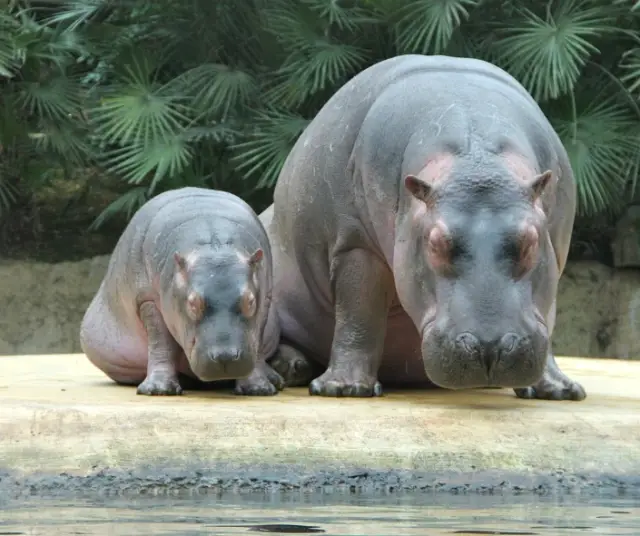Colombia, known for its biological diversity and lush landscapes, is home to a surprising population of hippos, a species native to Africa. The presence of these imposing mammals on Colombian soil has generated curiosity and, in some cases, concern.
Origins: The story of Pablo Escobar and his hippos
The unusual origin of hippos in Colombia dates back to the 1980s, around the time when infamous drug lord Pablo Escobar dominated drug trafficking in the country. Escobar, known for his ostentatious life and love of exotic animals, imported four hippos from Africa for his private zoo at Hacienda Nápoles, his sprawling ranch.
After Escobar's death in 1993, his properties were confiscated and his animals were left without care. However, hippos, which are robust and resistant animals, managed to survive and adapt to the Colombian climate and habitat. Over time, the initial small population of four individuals multiplied significantly, and the hippos began to explore other nearby bodies of water.
Adaptation to Colombia: a new home for African hippos
The story of the adaptation of African hippos to Colombia is fascinating and unique of its kind. Originally from Africa, these imposing mammals were initially introduced to Colombian soil by drug trafficker Pablo Escobar in the 1980s, as part of his private zoo at Hacienda Nápoles. After Escobar's death, the hippos were free in an unknown environment and embarked on a surprising journey of adaptation.
Despite the stark differences between African and Colombian habitats, hippos demonstrated amazing resilience. The tropical climate and the presence of bodies of water in Colombia offered favorable conditions for their survival. Over the years, these mammals multiplied and began to explore other areas, leading to a current population that exceeds 80 individuals.
The ability of hippos to adapt to a new home raises intriguing questions about their biology and behavior. Their resistance to such a significant change in the environment suggests a notable capacity for adaptation, highlighting the amazing flexibility of this particular species. The successful adaptation of African hippos in Colombia also underscores the ability of certain species to find opportunities in unexpected situations, even when faced with non-native environments.
As these mammals explored Colombian rivers and lakes, they embarked on an evolutionary process that has left its mark on the local landscape. Their presence, although initially linked to controversial events, has contributed to the formation of a new chapter in Colombia's ecology. This phenomenon, in addition to its environmental implications, highlights the complex interaction between human introduction of species and the surprising adaptive capacity of wildlife.
The adaptation of African hippos in Colombia also poses challenges in terms of management and conservation. As their population grows, concern intensifies about potential environmental impacts, such as water quality and alteration of surrounding vegetation. The sustainable management of this emerging population becomes a critical area of attention, requiring strategies that balance biodiversity conservation with the potential tourism and economic benefits that could arise.
Environmental impact
As the hippo population in Colombia grows, so does concern about their impact on the local ecosystem. In their natural habitat, hippos play a crucial role in regulating aquatic ecosystems, but their presence in Colombia poses unique challenges.
The nutrient-rich excretion of these mammals can have significant effects on the water quality of the aquatic bodies they occupy. Furthermore, their voracity can affect the surrounding vegetation, altering the natural balance of the local flora. This has led to debates about the need to manage and control the hippopotamus population in Colombia to mitigate possible negative impacts on the environment.
Management challenges: How to deal with hippos in Colombia?
Managing the growing hippopotamus population in Colombia presents significant challenges. Although spaying and neutering are possible options, these interventions are complex and expensive. Additionally, hippos' resistance to these procedures further complicates control efforts.
Some voices argue in favor of allowing the hippopotamus population to grow naturally, arguing that these animals could become a unique tourist attraction in Colombia. However, this perspective faces criticism that insists on the need to address the possible environmental impacts and risks associated with the presence of an exotic species in a non-native ecosystem.
As the debate over hippopotamus management in Colombia continues, there is a need to find sustainable solutions that balance the conservation of local biodiversity with the potential economic and tourism benefits that these animals could bring. Conservation experts, biologists and local authorities work together to better understand the ecology of hippos in Colombia and develop effective strategies for their management.
International collaboration also plays a key role, as the experience of other countries that have faced similar challenges can provide valuable insights. Lessons learned in places like Mexico, where problems with invasive species have been faced, can contribute to the formulation of policies and strategies to address the presence of hippos in Colombia.
